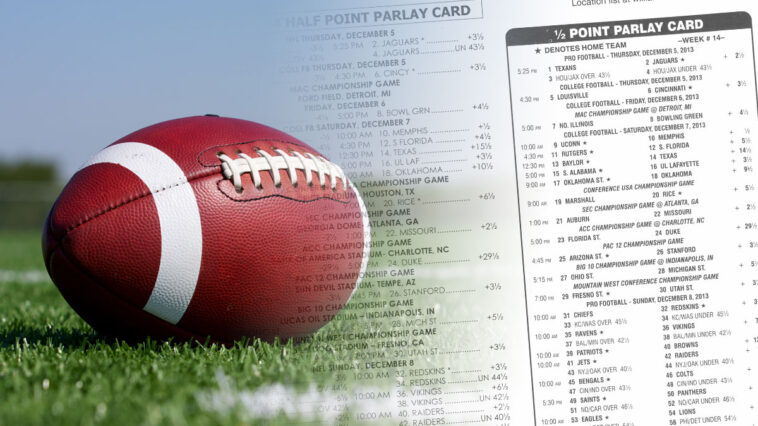When I went to high school in the ‘80s, I had a two-hour bus ride each way. I went to an all-boys private school, but it was mostly middle-class families that attended.
The two-hour ride would bring us through 10 cities and towns every day before we reached our destination. I was the first pick-up and last drop-off.
As you can imagine, we had a lot of time on our hands, and as they say, idle hands are the devil’s workshop. One of the many things that we did that could have meant big trouble was gambling.
A few friends of mine had some sort of association with a bookie in their town and started bringing parlay football betting cards on the bus. These cards allowed us to play from 3 to 15 games, and we could play for either $1 or $2. The latter would double the payout.
In the fall, we had to pick games that included both the NFL and NCAA football games. In the spring, we had USFL games to choose from (at least while they lasted). The USFL parlay cards had fewer teams, so we’d generally only have 5 to 8 games to choose.
I’d always choose the full 15 games during the fall. I’d pay the $2 so I could double my potential winnings to $600. In the three years that I played, I hit once. It was sheer luck. Of course, I did what any red-blooded guy in the ‘80s would do with $600. I spent the money on food, clothes, and most importantly, video games.
In retrospect, although I probably broke even playing, I was wasting my money. Not because parlay betting was bad, or that I was probably dealing with a less than reputable bookie, but because I really didn’t follow football. I knew a few teams and players, but I knew nothing that would help me make educated decisions when placing a bet.
While I’m still not a huge football fan, I learned over the years that if I bet on a game, in any sport, I need to be prepared to understand how the players and the teams perform.
What’s a Parlay Bet?
A football parlay bet is a wager that is placed on the results of two or more teams. In this type of bet, all teams selected must win. These bets are popular because of the higher payouts that the bettor can win.
The higher payouts are due to the difficulty in choosing the winners.
As anyone who ever placed a bet on a football game knows, picking one winner in a game can be hard enough, but adding more teams can be exponentially more difficult.
Depending on where you play, you can get big payouts on parlay bets. Which makes sense, since the more difficulty involved in the wager, the better the odds that the sportsbooks will give.
And the reason they give great odds is that parlay bets make sportsbooks money. The difficulty increases the profits for the sportsbook. It is estimated that about 7% to 9% of parlay bets win. That is compared to sports betting on the moneyline, which hovers between 25% to 35%, depending on the sport.
Reasons People Give to Not Place Parlay Bets
I’ve already mentioned that parlays are not the easiest bet to win. But I like to think of it this way: any bet can be hard to win. Especially if you are placing the same bet all the time. So, to me, it’s no excuse to avoid parlays.
Another excuse that I hear about parlay bets is that sportsbooks build in their commission or vigorish (vig) into the odds of the parlay, so you don’t see true odds. But this is true on almost any bet.
Online sportsbooks are not in the business of losing money, so if they lose a wager, they need to recoup somehow. It’s like playing poker or even baccarat at a casino where they charge a commission on the winnings. It’s because they aren’t making any money on the game itself.
The sportsbooks can make even more money by odds shaving. When this is done, the sportsbook is making a higher vig on the bet.
So when you look at the odds being offered by a sportsbook, take this into account.
Types of Parlay Cards
1/2 Point Parlay Card
One type of parlay betting card is the 1/2 point card. This type of card will show the point spread or total all ending in .5, so it’s impossible for the game to end up in a tie.
These cards are an advantage over other parlay bets. In most cases, the bettor will see a 1/2 point advantage over spreads in other types of bets because the spread will be shifted by the sportsbook either up or down by 1/2 a point. This is especially helpful when the 1/2 point is off of a 3 or a 7 point spread as about 1/4 of all games end in a difference of those numbers.
Teaser Parlay Card
A teaser card is a popular way to place a parlay bet because the spread is usually lower than other types of parlays or even standard bets.
On this type of card, the underdog team is given more points. The drawback on this type of bet is that the payouts are lower than other parlay bets. The reason is that you are given more of an advantage on the point spread.
A teaser card lets a player bet on as few as 3 teams or as many as 20 teams (in most cases).
Ties Win Parlay Cards
On cards that don’t have 1/2 points, the possibility exists for a tie to happen. This is when the spread creates a statistical tie between both teams.
On a normal parlay card, a tie would be erased from the bet as if you never even chose the game.
Because the number of games has been reduced on the card, the payout is reduced (or eliminated if you are brought down to two or fewer games).
So, in the above scenario, if you picked 10 games, you are reduced to 9 games. If all of the other games win, you will win as if you only chose 9 games instead of 10 since the tenth was a tie and thus eliminated.
On a ties win parlay card, the tie in the above scenario would be considered a win for you and would pay out accordingly.
A ties win card will have both whole points and half points.
A common occurrence on ties win cards is the absence of 3-point spreads. You’ll see either 2.5 or 3.5 as the spread.
The reason for this is that about 1/5 of all games are won by 3 points. This would create a huge advantage for anyone wagering. So the sportsbooks rarely use 3 as a benchmark.
Ties Lose Parlay Cards
A unique type of parlay is the ties lose card. These cards are not usually based on all games in a week. They tend to focus on games that take place on Sundays and Mondays only (as a caveat, you may find some that do the whole week, but they are not common).
Ties lose cards are among the hardest to win, and rarely does anyone who knows parlay strategy choose many games for the parlay.
I mentioned a statistic earlier that about 1/5th of all games have a 3-point margin of victory. On a ties lose card, anything that has a spread of 3 points is poison on a card because of the likelihood of losing.
Progressive Parlay
Another popular parlay is the progressive parlay.
Unlike a progressive electronic gaming machine where several machines are tied into each other to pay out a huge jackpot to the winner, a progressive parlay only depends on one bettor.
Progressive parlays work much the same as a regular parlay. You will still choose 3 to 15 games to bet on, and you will still pay a flat fee for the bet.
The difference is that you can have a game that you miss and still get paid.
In progressive parlays, you are generally allowed one loss for every three games you play above four.
Below is an example of what to expect on a progressive parlay card:
- A card with 4, 5, or 6 games chosen can have 1 loss
- A card with 7, 8, or 9 games chosen can have 2 losses
- A card with 10, 11, or 12 games chosen can have 3 losses
- A card with 13, 14, or 15 games chosen can have 4 losses
I mentioned that you pay a flat fee for this type of parlay card bet, and that is true. But it is more expensive than a standard parlay card.
Also, the payouts are lower on these types of cards.
To give you an example of the payouts, you may see a payout of 1200 to 1 on a 15-team pick on a standard parlay card. On a progressive, you may see that same win be reduced to 500 to 1. A win of 14/15 may only pay 50 to 1.
Pleaser Parlay Cards
I covered teaser parlay cards and explained them. A pleaser parlay is the opposite of a teaser. As a matter of fact, some sportsbooks actually refer to it as a reverse teaser.
A pleaser parlay works much like a teaser parlay, but instead of regular points, you get negative points.
- These types of bets have higher payouts because the chances of winning each are lowered due to the negative points.
- These types of cards will still require you to select between 3 and 15 games. You must win every game to win the bet.
The more you choose, the more money you can win, but the odds of losing increase with each game chosen.
As for ties, that will depend on the sportsbook. Some will eliminate the game, some will consider it a loss, and few will consider it a win. Remember, sportsbooks are in business to make money, so they have reasons for choosing their tie policies. Most that choose tie as win are trying to generate interest in parlay bets.
Unlike a teaser parley where you get the extra points on the spread, a pleaser takes those points away. The tradeoff is the higher payout.
You won’t find many sportsbooks that do pleaser bets as they aren’t very popular with gamblers.
Part of the reason for their lack of popularity is that most will have high house edges. Some house edges on the pleaser cards can be in the 90% range.
Round Robin Parlay Cards
Round robin parlay bets are two-part bets. The first part of the bet is much like a regular parlay card. You’ll choose between three and eight teams to win.
The second part is that you select between two and six teams to do the round robin.
In the round robin, you are pitting the scores of a team in one game against the score of a team in another game.
Let’s look at how this works using these teams:
- New England Patriots +5.5
- Miami Dolphins -3.5
- Dallas Cowboys +4
If you did a three-team round robin, the games would look like:
- Game 1: Patriots v. Dolphins
- Game 2: Patriots v. Cowboys
- Game 3: Dolphins v. Cowboys
On these types of cards, you are not paying a flat rate as you would for a standard parlay. Each game is paid for separately.
A great thing about round robin parlays is that you can lose a round robin and still win money.
Because of the difficulty of the round robin, they will usually pay well if you win.
Most sportsbooks take round robin parlay card bets, but they may not be listed as a standard offering. You may have to ask the sportsbook directly about how to place these types of bets or look under a prop bets section on their website.
The Delaware State Lottery
The state of Delaware decided to capitalize on the United States Supreme Court ruling of Murphy v. National Collegiate Athletic Association which ruled that the Professional and Amateur Sports Protection Act of 1992 (PASPA) was unconstitutional. This law essentially banned sports betting in all but five states.
While Delaware had a partial exemption under PASPA, they were still prevented from completely allowing sports betting.
That changed almost immediately after the court ruling. On June 5th, 2018, the Delaware Lottery expanded their parlay betting system to lottery retailers around the state, whereas previous to that date, these bets were restricted to racetracks and casinos.
The Delaware Lottery allows parlay betting on all NFL and college games that don’t involve a Delaware team.
Currently, the Delaware Lottery offers the following types of parlay betting cards:
- Early Bird Card – This is a standard parlay card but must be played on Monday or Tuesday. The players get better payouts by playing early. These cards only have NFL teams available.
- Half-Point Parlay Card – A standard 1/2 point card. Payouts range from 6.5 to 1 on a 3-team parlay to 2,500 to 1 on a 12-team parlay.
- Teaser Card – A standard teaser card where the payouts range from 12 to 5 on a 3-team parlay to 1,000 to 1 on a 20-team parlay.
- Super Teaser Card – This is much like a regular teaser card, but the favored teams have a smaller spread to cover. The underdog teams receive more points. Super Teaser Card payouts are lower than on the regular teaser cards because of the added advantage the bettor has on the point spread. On the card, you may choose between 4 and 20 teams. Wagering is available on both sides of a game because the point spreads have been adjusted. The payout starts at 11 to 5 and goes up to 80 to 1 based on the number of teams selected.
- Reverse Teaser Card – This is a standard pleaser card that the Delaware Lottery offers. The bettors can parlay as few as 3 and as many as 8 teams and receive payoffs ranging from 20 to 1 up to 5,000 to 1. These are only offered on NFL games.
- $100,000 Parlay Card – For a $5 bet, you select 15 games against the point spread. If you correctly pick the winners of all 15 games, you win $100,000. If there is more than one winner, the $100,000 prize is divided equally among the winning tickets. The $100,000 Parlay Card will also have a few (over/under) wagers every so often.
Currently, Delaware is the only state that offers parlay cards as part of their state lottery. But with the decision in Murphy v. National Collegiate Athletic Association, more states are looking at this as an option.
Conclusion
While I love betting on football parlay cards, I’ll be the first to admit that they’re not the greatest bets to make. In a lot of cases, they can be a pretty poor bet.
But, they’re relatively inexpensive. For $2 to $5, I can place a bet and possibly win several hundred or even thousands.
They also take a lot of work if you want to really win. It can require several hours of research to pick the perfect parlay.
In the end, however, the research and the time invested can prove valuable. If you win $1,000 for even 10 hours of research, you’ve just made $100 per hour. And that’s pretty good money.
Michael Stevens
Michael Stevens has been researching and writing topics involving the gambling industry for well over a decade now and is considered an expert on all things casino and sports betting. Michael has been writing for GamblingSites.org since early 2016. …





